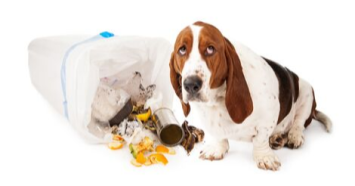
The concept of making an animal’s environment more interesting began in zoos because people didn’t like seeing captive animals pacing back and forth constantly and keepers knew the animals in their care were bored. At that time, no one knew what to do about it; animals were kept in cages and always had been.
In the last few decades, however, significant changes have been made in how animals in captivity are housed and the animals’ mental well-being is now considered as important as physical well-being. This has had significant benefits for our dogs, too.
Boredom is Bad
Dogs who are bored will get into trouble. A bored dog will bark, chew destructively, dig, or try to escape from the yard. A bored dog may develop self-destructive habits too, including excessive licking or chewing to the point of harming himself.
Boredom can be lessened by keeping the dog’s brain busy with training, playtime, and mental games when you’re at home and making sure the dog gets enough daily exercise so that his body is tired when you leave.
Environmental Enrichment for Dogs
Environmental enrichment is the process of making the animal’s living space interesting and stimulating so as to decrease boredom and its subsequent problems. Making things more interesting for your dog isn’t hard. However, you do need to be creative and vary what you do. If you do the same thing every day, that too can quickly become boring.
For example, food dispensing toys are great for relieving boredom and stress. At the same time, they make your dog’s environment more interesting. A few treats – or an entire meal – in the toy will keep your dog busy while you’re gone and, since this is the time when most dogs get into trouble, can be a big help.
Hide two or three food dispensing toys for your dog to find. Initially, the toys can be in easy to find locations and later, when your dog is good at finding them, you can make them harder to find. Vary the treats and the hiding spots to keep things interesting.
You can do the same thing with favorite toys. Hide them in different places and check when you get home; did your dog find them? If your dog spends time outside, you can leave him a block of ice with some treats frozen in it. Use a plastic bowl or small bucket as a mold. Fill it three quarters full of water and put it in the freezer. When the water is slushy, mix in some dog kibble, carrot chunks, apple slices, and bits of cooked meat. When frozen, turn it over and pop it out. Give it to your dog outside on a warm day.
You can dab some scents (cinnamon, lavender, orange, or other interesting scents) in a few places in the yard. You can hide a few toys in special spots. Be cautious hiding food though, if your yard is prone to ants or bees.
Some Cautions
Although environmental enrichment is easy, it does take some thought to avoid new behavior problems. Don’t leave food out without putting it in a food dispensing toy if your dog is prone to destructive chewing. Your dog might decide to chew on the spot where the food was left.
Don’t give your dog items that could cause a problem. For example, when he’s alone, don’t give your dog bones, rawhides, toys, or other chews that have pieces that could break off and be swallowed. He should have these only when you’re supervising him (if at all).